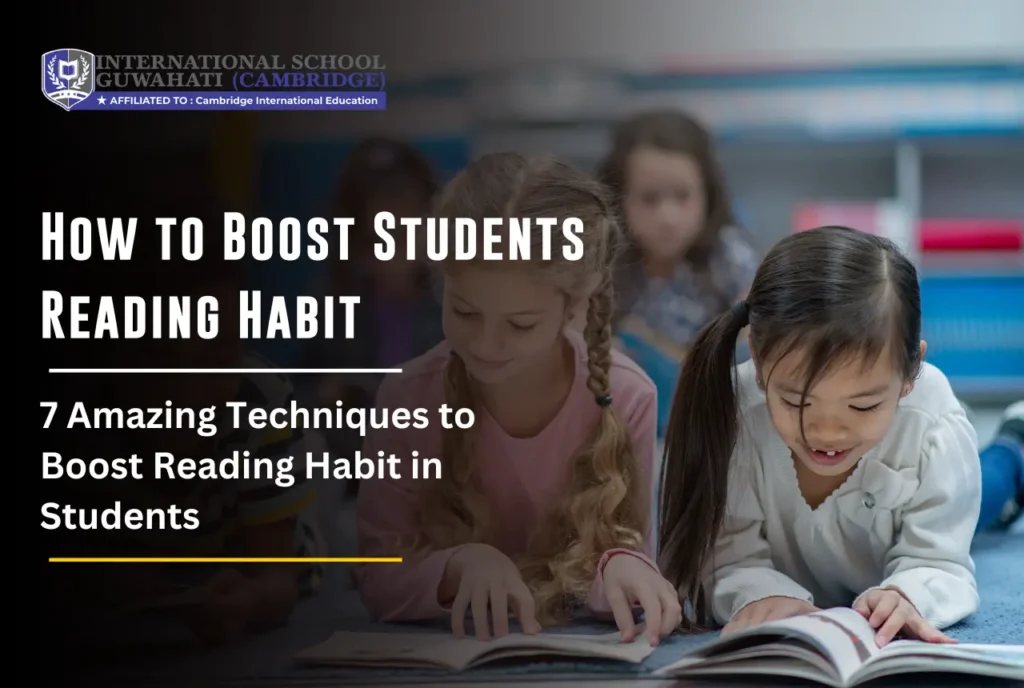![]()
The American entrepreneur, animator, writer, voice artist, and film producer, Walt Disney says,
“There is more treasure in books than in all the pirate’s loot on Treasure Island”
– Walt Disney
This quote sums up the importance and the fun of reading pretty much completely. Well, to help students explore the treasure in them, we are here to tell you how to boost students reading habits.
In a world where children want to be the best and look up to personalities like Elon Musk and Mark Zuckerberg, it is essential to get kids into the habit of reading from a very young age so they can reach their goals.
It is a basic and necessary part of human life because it helps us find and share knowledge. Reading is good for kids because it keeps their minds healthy and shapes who they become.
A strong reading habit also makes a growing child academically independent and broadens their knowledge sight.
7 Techniques on How to Boost Students Reading Habit
1. Spark Interest: Find the Right Books

People always come up with the opinion that they do not like reading because they assume books are boring. This assumption can only be broken with the right books and the right genre that people would enjoy reading.
To start a reading habit if you have never read any book before, you can try a genre you enjoy in films like horror, adventure, or fantasy.
This can engage you with an interesting story while you gradually get used to reading even when there are no illustrations.
2. Make it a Routine: Schedule a Reading Time Everyday
Reading is a skill that needs to be practiced often, just like any other skill. Making reading a regular part of a student’s daily schedule helps them value reading and make it a habit.
This set time could be before bed, on the way to or from school, or during a quiet break in the afternoon. Set small goals that you can reach, like reading for 15 minutes a day, and slowly add more time as you enjoy it more.
3. Make the Space Fun and Encouraging

Reading should be a good thing that you enjoy. Make a cozy reading nook with soft chairs, good lighting, and not many other things going on around you.
Reading out loud with younger kids is especially helpful. People can grow to love stories and words through the sound of your voice and the experience of being with you.
4. Make Reading an Experience You Can Interact With
It can get boring to read passively. Keeping kids interested in what they are reading is important for making reading a habit that lasts.
Students should keep reading journals where they can write down their emotions, thoughts, and guesses about what will happen next in the story. Reading can also be more fun if you talk about the book with your friends or join a book club.
A lot of websites and apps can turn reading into a game by adding tests, badges, and social features to keep students interested.
5. Lead by Example

Young children are very perceptive and often act like the people around them. Being a reader yourself is the best thing you can do to help children love reading.
Talk freely about the books you’re reading and share your favorite parts. Take the family or class to the library together. Students can be very motivated to read when they see how much you enjoy it.
6. Read Your Favorite Books Again
It might get old for you to read the same story over and over, but your child might love it. It’s fun for kids to find things in a story or picture that they missed the first time.
They can also make connections between the words on the page and the words they hear when they read again. Your kid might even start reading the book to you in the end.
7. Read Anytime Anywhere You Can

Managing to read between work, classes, or study sessions for 10 to 15 minutes is always beneficial in building a reading habit.
This will keep students or the reader engaged with the book even before the previously set reading time.
Why Students Don’t Like to Read: Understanding the Challenges
Students may have trouble reading for several reasons. Reading can be hard if you find the information hard to understand, don’t care about the subject, or are distracted by technology.
Reading quickly can also be hard for people with learning disabilities like dyslexia.
Too much short-form material and technology that moves quickly can make it hard for students to focus on longer texts because they have shorter attention spans.
Benefits of Reading for Students

Reading every day has a lot of benefits for kids. Reading helps kids do well in school by expanding their vocabulary, making it easier to understand what they read, and improving their critical thinking ability.
But the perks aren’t just for school. Reading helps kids develop their creativity, understanding, and emotional intelligence. Students can escape into new places, see things from different points of view, and learn more about themselves and the world around them.
Reading can also help you relax and deal with worry by giving you a break from the stresses of everyday life.
Conclusion
If you want to know how to boost students’ reading habits, try these seven great strategies as mentioned above. You must understand that a habit takes time to build.
There may be some days when children would not want to read at all. Remember that it is all part of the process.
You can open up the world of knowledge and imagination that lies inside the pages of a book by giving them constant effort and support. Ensure students are not too forced into it as it will only work against forming a strong habit.










